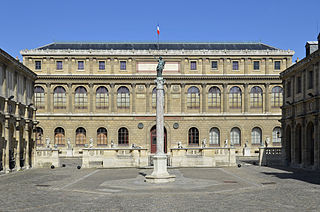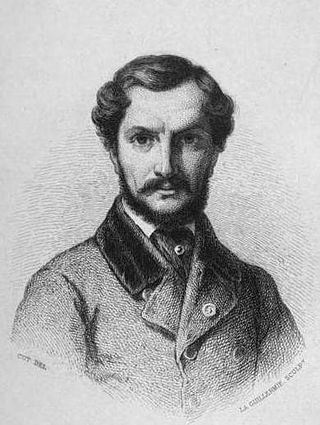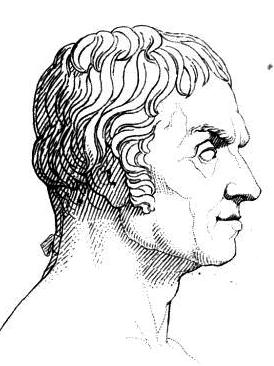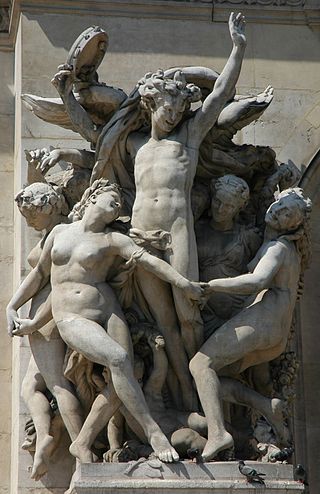

Jean-Joseph Perraud (26 April 1819, Jura - 2 November 1876) was a French academic sculptor. According to Eaton, "During the Second Empire no sculptor enjoyed a greater reputation", although his style fell out of fashion soon after his death.


Jean-Joseph Perraud (26 April 1819, Jura - 2 November 1876) was a French academic sculptor. According to Eaton, "During the Second Empire no sculptor enjoyed a greater reputation", although his style fell out of fashion soon after his death.
Perraud was a student at the École des Beaux-Arts from 1843 under Etienne-Jules Ramey and Augustin-Alexandre Dumont, co-winner of the Prix de Rome in 1847, officer in the Legion of Honor in 1867, and member of the Académie des Beaux-Arts.
Perraud died in Paris. He is buried in Montparnasse Cemetery.

James Pradier was a Genevan-born French sculptor best known for his work in the neoclassical style.

François Rude was a French sculptor, best known for the Departure of the Volunteers, also known as La Marseillaise on the Arc de Triomphe in Paris. (1835–36). His work often expressed patriotic themes, as well as the transition from neo-classicism to romanticism.

The Beaux-Arts de Paris, formally the École nationale supérieure des beaux-arts, is a French grande école whose primary mission is to provide high-level fine arts education and training. The art school, which is part of the Paris Sciences et Lettres University, is located on two sites: Saint-Germain-des-Prés in Paris, and Saint-Ouen.

Antoine-Denis Chaudet was a French sculptor who worked in the neoclassical style. He was born and died in Paris.

Pierre-Jean David was a French sculptor, medalist and active freemason. He adopted the name David d'Angers, following his entry into the studio of the painter Jacques-Louis David in 1809 as a way of both expressing his patrimony and distinguishing himself from the master painter.

Gustave Adolphe Désiré Crauck was a French sculptor with a long distinguished career.

Francisque Joseph Duret was a French sculptor, son and pupil of François-Joseph Duret (1732–1816).

Charles-François Lebœuf, called Nanteuil was a French sculptor.

Étienne-Jules Ramey, called Ramey fils, was a French sculptor.

Claude Ramey was a French sculptor.

Jean-Marie Bienaimé Bonnassieux was a French sculptor.

Jean-Guillaume Moitte was a French sculptor.
Jean-Louis Brian was a French sculptor.

François Gaspard Aimé Lanno was a French sculptor. He was a pupil of François-Frédéric Lemot and Pierre Cartellier. In 1827, he won jointly with Jean-Louis Jaley the Prix de Rome for sculpture with a bas-relief Mucius Scævola devant Porsenna.

Jean-Louis Nicolas Jaley was a French sculptor.

Bernard-Gabriel Seurre or Seurre the Elder was a French sculptor. His younger brother Charles Émile Seurre (1798–1858) was also a sculptor.

Jean Turcan was a French sculptor who specialized particularly in public figures.

La Danse is an 1868 sculpture by the French artist Jean-Baptiste Carpeaux. It was one of four sculptural groups made from Echaillon marble that decorate the façade of the Opera Garnier in Paris, two to either side of the entrance at ground level. The work was installed in 1869, and widely criticised as obscene. It was attacked in August 1869 when an anonymous vandal threw black ink over it. The scandal subsided after the outbreak of the Franco-Prussian War in 1870, and the original statue remained on the façade at the opera until it was transferred to the Louvre Museum in 1964 and replaced by a copy. The original was moved to the Musée d'Orsay in 1986.

French sculpture has been an original and influential component of world art since the Middle Ages. The first known French sculptures date to the Upper Paleolithic age. French sculpture originally copied ancient Roman models, then found its own original form in the decoration of Gothic architecture. French sculptors produced important works of Baroque sculpture for the decoration of the Palace of Versailles. In the 19th century, the sculptors Auguste Rodin and Edgar Degas created a more personal and non-realistic style, which led the way to modernism in the 20th century, and the sculpture of Pablo Picasso, Georges Braque, Marcel Duchamp and Jean Arp.

The expansion of the Louvre under Napoleon III in the 1850s, known at the time and until the 1980s as the Nouveau Louvre or Louvre de Napoléon III, was an iconic project of the Second French Empire and a centerpiece of its ambitious transformation of Paris. Its design was initially produced by Louis Visconti and, after Visconti's death in late 1853, modified and executed by Hector-Martin Lefuel. It represented the completion of a centuries-long project, sometimes referred to as the grand dessein, to connect the old Louvre Palace around the Cour Carrée with the Tuileries Palace to the west. Following the Tuileries' arson at the end of the Paris Commune in 1871 and demolition a decade later, Napoleon III's nouveau Louvre became the eastern end of Paris's axe historique centered on the Champs-Élysées.